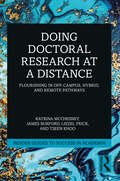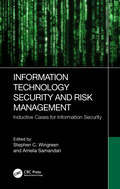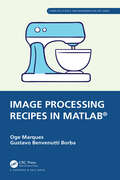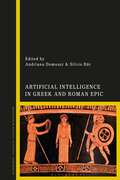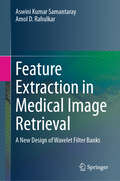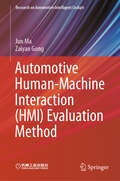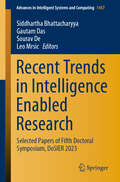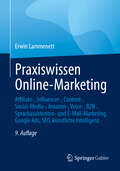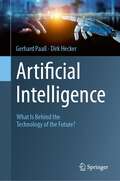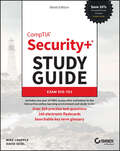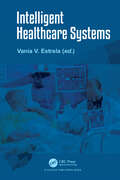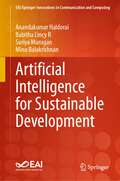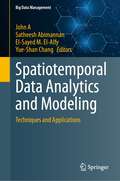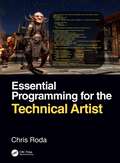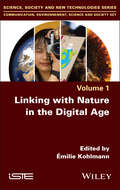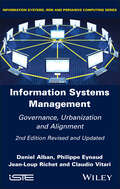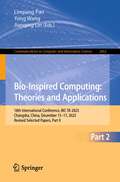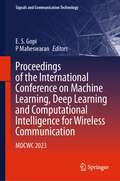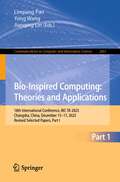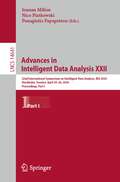- Table View
- List View
Doing Doctoral Research at a Distance: Flourishing In Off-Campus, Hybrid, and Remote Pathways (Insider Guides to Success in Academia)
by Katrina McChesney James Burford Liezel Frick Tseen KhooEmerging from personal experience and empirical research, Doing Doctoral Research at a Distance is a key companion text for doctoral students from a range of research fields and geographical contexts who are undertaking off-campus, hybrid, and remote pathways. Offering guidance about the entire off-campus doctoral journey, the book introduces contexts of distance study; key information to get off to a flying start; organising time, space and plans to get work done; juggling employment, family and other commitments alongside distance study; doctoral identity and wellbeing; working with doctoral supervisors at a distance; accessing research culture at a distance; and managing the bumps along the road of the distance doctorate. Written for doctoral researchers, this book offers strategies to help those working at a distance to flourish. This book is ideally suited for those contemplating distance study, distance doctoral students who are starting their off-campus journey, and supervisors and others who are working with distance doctoral researchers.‘Insider Guides to Success in Academia’ offers support and practical advice to doctoral students and early-career researchers. Covering the topics that really matter, but which often get overlooked, this indispensable series provides practical and realistic guidance to address many of the needs and challenges of trying to operate, and remain, in academia. These neat pocket guides fill specific and significant gaps in current literature. Each book offers insider perspectives on the often implicit rules of the game – the things you need to know but usually aren’t told by institutional postgraduate support, researcher development units, or supervisors – and will address a practical topic that is key to career progression. They are essential reading for doctoral students, earlycareer researchers, supervisors, mentors, or anyone looking to launch or maintain their career in academia.
Doing Doctoral Research at a Distance: Flourishing In Off-Campus, Hybrid, and Remote Pathways (Insider Guides to Success in Academia)
by Katrina McChesney James Burford Liezel Frick Tseen KhooEmerging from personal experience and empirical research, Doing Doctoral Research at a Distance is a key companion text for doctoral students from a range of research fields and geographical contexts who are undertaking off-campus, hybrid, and remote pathways. Offering guidance about the entire off-campus doctoral journey, the book introduces contexts of distance study; key information to get off to a flying start; organising time, space and plans to get work done; juggling employment, family and other commitments alongside distance study; doctoral identity and wellbeing; working with doctoral supervisors at a distance; accessing research culture at a distance; and managing the bumps along the road of the distance doctorate. Written for doctoral researchers, this book offers strategies to help those working at a distance to flourish. This book is ideally suited for those contemplating distance study, distance doctoral students who are starting their off-campus journey, and supervisors and others who are working with distance doctoral researchers.‘Insider Guides to Success in Academia’ offers support and practical advice to doctoral students and early-career researchers. Covering the topics that really matter, but which often get overlooked, this indispensable series provides practical and realistic guidance to address many of the needs and challenges of trying to operate, and remain, in academia. These neat pocket guides fill specific and significant gaps in current literature. Each book offers insider perspectives on the often implicit rules of the game – the things you need to know but usually aren’t told by institutional postgraduate support, researcher development units, or supervisors – and will address a practical topic that is key to career progression. They are essential reading for doctoral students, earlycareer researchers, supervisors, mentors, or anyone looking to launch or maintain their career in academia.
Information Technology Security and Risk Management: Inductive Cases for Information Security
by Stephen C. Wingreen Amelia SamandariInformation Technology Security and Risk Management: Inductive Cases for Information Security is a compilation of cases that examine recent developments and issues that are relevant to IT security managers, risk assessment and management, and the broader topic of IT security in the 21st century. As the title indicates, the cases are written and analyzed inductively, which is to say that the authors allowed the cases to speak for themselves, and lead where they would, rather than approach the cases with presuppositions or assumptions regarding what the case should be "about". In other words, the authors were given broad discretion to interpret a case in the most interesting and relevant manner possible; any given case may be "about" many things, depending on the perspective adopted by the reader, and many different lessons may be learned. The inductive approach of these cases reflects the design philosophy of the advanced IT Security and Risk Management course we teach on the topic here at the University of Canterbury, where all discussions begin with the analysis of a specific case of interest and follow the most interesting and salient aspects of the case in evidence. In our course, the presentation, analysis, and discussion of a case are followed by a brief lecture to address the conceptual, theoretical, and scholarly dimensions arising from the case. The inductive approach to teaching and learning also comes with a huge advantage – the students seem to love it, and often express their appreciation for a fresh and engaging approach to learning the sometimes-highly-technical content of an IT security course. As instructors, we are also grateful for the break in the typical scripted "chalk-and-talk" of a university lecture afforded by the spontaneity of the inductive approach.We were motivated to prepare this text because there seems to be no other book of cases dedicated to the topic of IT security and risk management, and because of our own success and satisfaction with inductive teaching and learning. We believe this book would be useful either for an inductive, case-based course like our own or as a body of cases to be discussed in a more traditional course with a deductive approach. There are abstracts and keywords for each case, which would help instructors select cases for discussions on specific topics, and PowerPoint slides are available as a guide for discussion about a given case.
Information Technology Security and Risk Management: Inductive Cases for Information Security
by Stephen C. Wingreen Amelia SamandariInformation Technology Security and Risk Management: Inductive Cases for Information Security is a compilation of cases that examine recent developments and issues that are relevant to IT security managers, risk assessment and management, and the broader topic of IT security in the 21st century. As the title indicates, the cases are written and analyzed inductively, which is to say that the authors allowed the cases to speak for themselves, and lead where they would, rather than approach the cases with presuppositions or assumptions regarding what the case should be "about". In other words, the authors were given broad discretion to interpret a case in the most interesting and relevant manner possible; any given case may be "about" many things, depending on the perspective adopted by the reader, and many different lessons may be learned. The inductive approach of these cases reflects the design philosophy of the advanced IT Security and Risk Management course we teach on the topic here at the University of Canterbury, where all discussions begin with the analysis of a specific case of interest and follow the most interesting and salient aspects of the case in evidence. In our course, the presentation, analysis, and discussion of a case are followed by a brief lecture to address the conceptual, theoretical, and scholarly dimensions arising from the case. The inductive approach to teaching and learning also comes with a huge advantage – the students seem to love it, and often express their appreciation for a fresh and engaging approach to learning the sometimes-highly-technical content of an IT security course. As instructors, we are also grateful for the break in the typical scripted "chalk-and-talk" of a university lecture afforded by the spontaneity of the inductive approach.We were motivated to prepare this text because there seems to be no other book of cases dedicated to the topic of IT security and risk management, and because of our own success and satisfaction with inductive teaching and learning. We believe this book would be useful either for an inductive, case-based course like our own or as a body of cases to be discussed in a more traditional course with a deductive approach. There are abstracts and keywords for each case, which would help instructors select cases for discussions on specific topics, and PowerPoint slides are available as a guide for discussion about a given case.
Image Processing Recipes in MATLAB® (Chapman & Hall/CRC Computer Science and Engineering Recipes Series)
by Oge Marques Gustavo Benvenutti BorbaLeveraging the latest developments in MATLAB and its image processing toolbox, this 'cookbook' is a collection of 30 practical recipes for image processing, ranging from foundational techniques to recently published algorithms. Presented in a clear and meaningful sequence, these recipes are prepared with the reader in mind, allowing one to focus on particular topics or read as a whole from cover to cover.Key Features: A practical, user-friendly guide that equips researchers and practitioners with the tools to implement efficient image processing workflows in MATLAB. Each recipe is presented through clear, step-by-step instructions and rich visual examples. Each recipe contains its own source code, explanations, and figures, making the book an excellent standalone resource for quick reference. Strategically structured to aid sequential learning, yet with self-contained chapters for those seeking solutions to specific image processing challenges. The book serves as a concise and readable practical reference to deploy image processing pipelines in MATLAB quickly and efficiently. With its accessible and practical approach, the book is a valuable guide for those who navigate this evolving area, including researchers, students, developers, and practitioners in the fields of image processing, computer vision, and image analysis.
Image Processing Recipes in MATLAB® (Chapman & Hall/CRC Computer Science and Engineering Recipes Series)
by Oge Marques Gustavo Benvenutti BorbaLeveraging the latest developments in MATLAB and its image processing toolbox, this 'cookbook' is a collection of 30 practical recipes for image processing, ranging from foundational techniques to recently published algorithms. Presented in a clear and meaningful sequence, these recipes are prepared with the reader in mind, allowing one to focus on particular topics or read as a whole from cover to cover.Key Features: A practical, user-friendly guide that equips researchers and practitioners with the tools to implement efficient image processing workflows in MATLAB. Each recipe is presented through clear, step-by-step instructions and rich visual examples. Each recipe contains its own source code, explanations, and figures, making the book an excellent standalone resource for quick reference. Strategically structured to aid sequential learning, yet with self-contained chapters for those seeking solutions to specific image processing challenges. The book serves as a concise and readable practical reference to deploy image processing pipelines in MATLAB quickly and efficiently. With its accessible and practical approach, the book is a valuable guide for those who navigate this evolving area, including researchers, students, developers, and practitioners in the fields of image processing, computer vision, and image analysis.
Artificial Intelligence in Greek and Roman Epic
This is the first scholarly exploration of concepts and representations of Artificial Intelligence in ancient Greek and Roman epic, including their reception in later literature and culture. Contributors look at how Hesiod, Homer, Apollonius of Rhodes, Moschus, Ovid and Valerius Flaccus crafted the first literary concepts concerned with automata and the quest for artificial life, as well as technological intervention improving human life.Parts one and two consider, respectively, archaic Greek, and Hellenistic and Roman, epics. Contributors explore the representations of Pandora in Hesiod, and Homeric automata such as Hephaestus' wheeled tripods, the Phaeacian king Alcinous' golden and silver guard dogs, and even the Trojan Horse. Later examples cover Artificial Intelligence and automation (including Talos) in the Argonautica of Apollonius and Valerius Flaccus, and Pygmalion's ivory woman in Ovid's Metamorphoses. Part three underlines how these concepts benefit from analysis of the ekphrasis device, within which they often feature. These chapters investigate the cyborg potential of the epic hero and the literary implications of ancient technology. Moving into contemporary examples, the final chapters consider the reception of ancient literary Artificial Intelligence in contemporary film and literature, such as the Czech science-fiction epic Starvoyage, or Small Cosmic Odyssey by Jan Kr?esadlo (1995) and the British science-fiction novel The Holy Machine by Chris Beckett (2004).
Artificial Intelligence in Greek and Roman Epic
by Andriana Domouzi and Silvio BärThis is the first scholarly exploration of concepts and representations of Artificial Intelligence in ancient Greek and Roman epic, including their reception in later literature and culture. Contributors look at how Hesiod, Homer, Apollonius of Rhodes, Moschus, Ovid and Valerius Flaccus crafted the first literary concepts concerned with automata and the quest for artificial life, as well as technological intervention improving human life.Parts one and two consider, respectively, archaic Greek, and Hellenistic and Roman, epics. Contributors explore the representations of Pandora in Hesiod, and Homeric automata such as Hephaestus' wheeled tripods, the Phaeacian king Alcinous' golden and silver guard dogs, and even the Trojan Horse. Later examples cover Artificial Intelligence and automation (including Talos) in the Argonautica of Apollonius and Valerius Flaccus, and Pygmalion's ivory woman in Ovid's Metamorphoses. Part three underlines how these concepts benefit from analysis of the ekphrasis device, within which they often feature. These chapters investigate the cyborg potential of the epic hero and the literary implications of ancient technology. Moving into contemporary examples, the final chapters consider the reception of ancient literary Artificial Intelligence in contemporary film and literature, such as the Czech science-fiction epic Starvoyage, or Small Cosmic Odyssey by Jan Kr?esadlo (1995) and the British science-fiction novel The Holy Machine by Chris Beckett (2004).
Feature Extraction in Medical Image Retrieval: A New Design of Wavelet Filter Banks
by Aswini Kumar Samantaray Amol D. RahulkarMedical imaging is fundamental to modern healthcare, and its widespread use has resulted in creation of image databases. These repositories contain images from a diverse range of modalities, multidimensional as well as co-aligned multimodality images. These image collections offer opportunity for evidence-based diagnosis, teaching, and research. Advances in medical image analysis over last two decades shows there are now many algorithms and ideas available that allow to address medical image analysis tasks in commercial solutions with sufficient performance in terms of accuracy, reliability and speed. Content-based image retrieval (CBIR) is an image search technique that complements the conventional text-based retrieval of images by using visual features, such as color, texture, and shape, as search criteria. This book emphasizes the design of wavelet filter-banks as efficient and effective feature descriptors for medical image retrieval.Firstly, a generalized novel design of a family of multiplier-free orthogonal wavelet filter-banks is presented. In this, the dyadic filter coefficients are obtained based on double-shifting orthogonality property with allowable deviation from original filter coefficients. Next, a low complex symmetric Daub-4 orthogonal wavelet filter-bank is presented. This is achieved by slightly altering the perfect reconstruction condition to make designed filter-bank symmetric and to obtain dyadic filter coefficients. In third contribution, the first dyadic Gabor wavelet filter-bank is presented based on slight alteration in orientation parameter without disturbing remaining Gabor wavelet parameters. In addition, a novel feature descriptor based on the design of adaptive Gabor wavelet filter-bank is presented. The use of Maximum likelihood estimation is suggested to measure the similarity between the feature vectors of heterogeneous medical images. The performance of the suggested methods is evaluated on three different publicly available databases namely NEMA, OASIS and EXACT09. The performance in terms of average retrieval precision, average retrieval recall and computational time are compared with well-known existing methods.
Automotive Human-Machine Interaction (Research on Automotive Intelligent Cockpit)
by Jun Ma Zaiyan GongThis book focuses on the evaluation methodology for automotive human-machine interaction (HMI), which aim to reduce driving distractions, lower operational loads, optimize user experience design, and enhance user value.The book is divided into three parts. The first part, consisting of Chapters 1–3, introduces the evolution of automotive HMI and proposes a three-dimensional orthogonal evaluation system for automotive HMI that is comprehensive, systematic, and quantifiable. This evaluation system incorporates all evaluation items into a spatial matrix consisting of three dimensions: interaction tasks, interaction modalities, and evaluation indexes. The second part provides a comprehensive presentation and in-depth discussion of the evaluation indexes. The three rational evaluation indexes are utility, safety, and efficiency, which can be tested by the real-car driving simulator. The four emotional evaluation indexes are cognition, intelligence, value, and aesthetics. In orderto standardize the latter two subjective indexes, this book summarizes common differences in value between Chinese and European users and organizes typical aesthetic orientations in automotive UI based on art history research. The third part introduces the application of this HMI evaluation system in the automotive R&D process, including how to integrate the evaluation into a real product development process to achieve efficient product iteration.This book is suitable for intelligent cockpit and HMI designers, engineers, and researchers. It is also used as a reference for product managers and students in the field of intelligent connected vehicles.
Recent Trends in Intelligence Enabled Research: Selected Papers of Fifth Doctoral Symposium, DoSIER 2023 (Advances in Intelligent Systems and Computing #1457)
by Siddhartha Bhattacharyya Gautam Das Sourav De Leo MrsicThis book gathers extended versions of papers presented at DoSIER 2023 (Fifth Doctoral Symposium on Intelligence Enabled Research, held at Cooch Behar Government Engineering College, West Bengal, India, during December 20–21, 2023). The papers address the rapidly expanding research area of computational intelligence, which, no longer limited to specific computational fields, has since made inroads in signal processing, smart manufacturing, predictive control, robot navigation, smart cities, and sensor design, to name but a few. Presenting chapters written by experts active in these areas, the book offers a valuable reference guide for researchers and industrial practitioners alike and inspires future studies.
Praxiswissen Online-Marketing: Affiliate-, Influencer-, Content-, Social-Media-, Amazon-, Voice-, B2B-, Sprachassistenten- und E-Mail-Marketing, Google Ads, SEO, künstliche Intelligenz
by Erwin LammenettWie gelingt profitables Online-Marketing? Erwin Lammenett, seit über 25 Jahren Experte für digitales Marketing, erläutert praxisnah und theoretisch fundiert die gesamte Palette der Online-Marketing-Instrumente. Sie erfahren, wie Sie diese Instrumente erfolgreich nutzen, welche Sie sinnvoll miteinander kombinieren können und wie Sie ein effizientes Controlling aufbauen. Angesprochen werden Führungskräfte und Mitarbeiter aus Marketing und PR, Produktmanager, Unternehmensberater, aber auch Dozierende und Studierende mit dem Schwerpunkt Marketing. Alle Kapitel enthalten dynamische Servicelinks, über die Inhalte jederzeit und kurzfristig angepasst werden können. In der 9. Auflage wurden alle Kapitel überarbeitet und aktualisiert. Viele wurden um neue Entwicklungen ergänzt, insbesondere wurde auf neue Entwicklungen eingegangen, die auf künstlicher Intelligenz basieren.
Artificial Intelligence: What Is Behind the Technology of the Future?
by Gerhard Paaß Dirk HeckerArtificial Intelligence (AI) is already present in our daily routines, and in the future, we will encounter it in almost every aspect of life – from analyzing X-rays for medical diagnosis, driving autonomous cars, maintaining complex machinery, to drafting essays on environmental problems and drawing imaginative pictures. The potentials of AI are enormous, while at the same time many myths, uncertainties and challenges circulate that need to be tackled. The English translation of the book “Künstliche Intelligenz – Was steckt hinter der Technologie der Zukunft?” originally published in German (Springer Vieweg, 2020), this book is addressed to the general public, from interested citizens to corporate executives who want to develop a better and deeper understanding of AI technologies and assess their consequences. Mathematical basics, terminology, and methods are explained in understandable language. Adaptations to different media such as images, text, and speech and the corresponding generative models are introduced. A concluding discussion of opportunities and challenges helps readers evaluate new developments, demystify them, and assess their relevance for the future.
CompTIA Security+ Study Guide with over 500 Practice Test Questions: Exam SY0-701 (Sybex Study Guide)
by Mike Chapple David SeidlMaster key exam objectives and crucial cybersecurity concepts for the CompTIA Security+ SY0-701 exam, along with an online test bank with hundreds of practice questions and flashcards In the newly revised ninth edition of CompTIA Security+ Study Guide: Exam SY0-701, veteran cybersecurity professionals and educators Mike Chapple and David Seidl deliver easy-to-follow coverage of the security fundamentals tested by the challenging CompTIA SY0-701 exam. You’ll explore general security concepts, threats, vulnerabilities, mitigations, security architecture and operations, as well as security program management and oversight. You’ll get access to the information you need to start a new career—or advance an existing one—in cybersecurity, with efficient and accurate content. You’ll also find: Practice exams that get you ready to succeed on your first try at the real thing and help you conquer test anxiety Hundreds of review questions that gauge your readiness for the certification exam and help you retain and remember key concepts Complimentary access to the online Sybex learning environment, complete with hundreds of additional practice questions and flashcards, and a glossary of key terms, all supported by Wiley's support agents who are available 24x7 via email or live chat to assist with access and login questions Perfect for everyone planning to take the CompTIA SY0-701 exam, as well as those aiming to secure a higher-level certification like the CASP+, CISSP, or CISA, this study guide will also earn a place on the bookshelves of anyone who’s ever wondered if IT security is right for them. It’s a must-read reference!And save 10% when you purchase your CompTIA exam voucher with our exclusive WILEY10 coupon code.
Intelligent Healthcare Systems
by Vania V. EstrelaThe book sheds light on medical cyber-physical systems while addressing image processing, microscopy, security, biomedical imaging, automation, robotics, network layers’ issues, software design, and biometrics, among other areas. Hence, solving the dimensionality conundrum caused by the necessity to balance data acquisition, image modalities, different resolutions, dissimilar picture representations, subspace decompositions, compressed sensing, and communications constraints. Lighter computational implementations can circumvent the heavy computational burden of healthcare processing applications. Soft computing, metaheuristic, and deep learning ascend as potential solutions to efficient super-resolution deployment. The amount of multi-resolution and multi-modal images has been augmenting the need for more efficient and intelligent analyses, e.g., computer-aided diagnosis via computational intelligence techniques. This book consolidates the work on artificial intelligence methods and clever design paradigms for healthcare to foster research and implementations in many domains. It will serve researchers, technology professionals, academia, and students working in the area of the latest advances and upcoming technologies employing smart systems’ design practices and computational intelligence tactics for medical usage. The book explores deep learning practices within particularly difficult computational types of health problems. It aspires to provide an assortment of novel research works that focuses on the broad challenges of designing better healthcare services.
Artificial Intelligence for Sustainable Development (EAI/Springer Innovations in Communication and Computing)
by Anandakumar Haldorai Babitha Lincy R Suriya Murugan Minu BalakrishnanThis book delves into the synergy between AI and sustainability. This comprehensive guide illuminates the latest trends and cutting-edge techniques, offering invaluable insights for researchers, practitioners, and policymakers interested in the cross-section of AI and sustainability. The authors illustrate how AI-driven innovations are revolutionizing environmental conservation, urban planning, healthcare, and more. The book also considers the ethical considerations and governance frameworks crucial to harnessing AI's potential for global benefit. Whether a seasoned expert or a curious newcomer, this book empowers readers to navigate the dynamic landscape of AI and sustainability, paving the way for a more eco-conscious and equitable world.
Spatiotemporal Data Analytics and Modeling: Techniques and Applications (Big Data Management)
by John A Satheesh Abimannan El-Sayed M. El-Alfy Yue-Shan ChangWith the growing advances in technology and transformation to digital services, the world is becoming more connected and more complex. Huge heterogeneous data are generated at rapid speed from various types of sensors. Augmented with artificial intelligence and machine learning and internet of things, latent relations, and new insights can be captured helping in optimizing plans and resource utilization, improving infrastructure, and enhancing quality of services. A “spatial data management system” is a way to take care of data that has something to do with space. This could include data such as maps, satellite images, and GPS data. A temporal data management system is a system designed to manage data that has a temporal component. This could include data such as weather data, financial data, and social media data. Some advanced techniques used in spatial and temporal data management systems include geospatial indexing for efficient querying and retrieval of location-based data, time-series analysis for understanding and predicting temporal patterns in datasets like weather or financial trends, machine learning algorithms for uncovering hidden patterns and correlations in large and complex datasets, and integration with Internet of Things (IoT) technologies for real-time data collection and analysis. These techniques, augmented with artificial intelligence, enable the extraction of latent relations and insights, thereby optimizing plans, improving infrastructure, and enhancing the quality of services. This book provides essential technical knowledge, best practices, and case studies on the state-of-the-art techniques of artificial intelligence and machine learning for spatiotemporal data analysis and modeling. The book is composed of several chapters written by experts in their fields and focusing on several applications including recommendation systems, big data analytics, supply chains and e-commerce, energy consumption and demand forecasting,and traffic and environmental monitoring. It can be used as academic reference at graduate level or by professionals in science and engineering related fields such as data science and engineering, big data analytics and mining, artificial intelligence, machine learning and deep learning, cloud computing, and internet of things.
Essential Programming for the Technical Artist
by Chris RodaThis book is based on a successful curriculum designed to elevate technical artists with no programming experience up to essential programming competency as quickly as possible. Instead of abstract, theoretical problems, the curriculum employs familiar applications encountered in real production environments to demonstrate each lesson.Written with artists in mind, this book introduces novice programmers to the advantageous world of Python programming with relevant and familiar examples. Any digital artists (not just technical artists) will find this book helpful in assisting with day-to-day production activities.Concentrating upon subjects relevant to the creation of computer graphic assets, this book introduces Python basics, functions, data types, object-oriented programming, exception handling, file processing, graphical user interface creation, PEP 8 standards, and regular expressions. Programming within the SideFX Houdini 3D animation software provides a familiar environment for artists to create and experiment with the covered Python topics.
Essential Programming for the Technical Artist
by Chris RodaThis book is based on a successful curriculum designed to elevate technical artists with no programming experience up to essential programming competency as quickly as possible. Instead of abstract, theoretical problems, the curriculum employs familiar applications encountered in real production environments to demonstrate each lesson.Written with artists in mind, this book introduces novice programmers to the advantageous world of Python programming with relevant and familiar examples. Any digital artists (not just technical artists) will find this book helpful in assisting with day-to-day production activities.Concentrating upon subjects relevant to the creation of computer graphic assets, this book introduces Python basics, functions, data types, object-oriented programming, exception handling, file processing, graphical user interface creation, PEP 8 standards, and regular expressions. Programming within the SideFX Houdini 3D animation software provides a familiar environment for artists to create and experiment with the covered Python topics.
Linking with Nature in the Digital Age
by Émilie KohlmannThe use of digital technology in our societies is growing to meet the ever-increasing challenges of data collection, raising awareness, education and understanding nature. Artificial intelligence, for example, appears to be the answer to collecting massive amounts of data on biodiversity at a global scale and facilitating citizen participation in such data collection. Linking with Nature in the Digital Age explores the reconfiguration of our relationship with nature within this digital framework. This book examines this mediated linking from three angles. Firstly, it shows how digital technology can foster the development of links to nature. Then, it describes in greater detail the materiality of these links and how they have evolved with the developments in information technology. Finally, it questions the belief in the digital as a facilitator and opens up new perspectives on our relationship with nature and the living world
Information Systems Management: Governance, Urbanization and Alignment
by Daniel Alban Philippe Eynaud Jean-Loup Richet Claudio VitariInformation Systems Management is intended to sensitize the heads of organizations to the issues raised by information systems (IS). Through its pedagogical presentation, this book ensures that issues related to IS are not left solely to the experts in the field. This book combines and analyzes three key concepts in IS science: governance, urbanization and alignment. While governance implies the implementation of a certain number of means, bodies and procedures to manage IS more effectively, urbanization involves visualization methods to enable the manager to take into account the different levels of the organization of an IS and their coherence. Finally, alignment assesses the ability of the IS to make a significant contribution to the organization’s strategy
Bio-Inspired Computing: 18th International Conference, BIC-TA 2023, Changsha, China, December 15–17, 2023, Revised Selected Papers, Part II (Communications in Computer and Information Science #2062)
by Linqiang Pan Yong Wang Jianqing LinThe two-volume set CCIS 2061 and 2062 constitutes the refereed post-conference proceedings of the 18th International Conference on Bio-Inspired Computing: Theories and Applications, BIC-TA 2023, held in Changsha, China, during December 15–17, 2023.The 64 revised full papers presented in these proceedings were carefully reviewed and selected from 168 submissions. The papers are organized in the following topical sections: Volume I: Evolutionary Computation and Swarm Intelligence; and Membrane Computing and DNA ComputingVolume II: Machine Learning and Applications; and Intelligent Control and Application.
Proceedings of the International Conference on Machine Learning, Deep Learning and Computational Intelligence for Wireless Communication: MDCWC 2023 (Signals and Communication Technology)
by E. S. Gopi P MaheswaranThis book is a collection of best selected research papers presented at the 2nd Conference on Machine Learning, Deep Learning and Computational Intelligence for Wireless Communication (MDCWC 2023) held during June 22-24th, 2023, at the National Institute of Technology Tiruchirappalli, India. The presented papers are grouped under the following topics (a) Machine learning, Deep learning and Computational intelligence algorithms (b) Wireless communication systems and (c) Mobile data applications. The topics include the latest research and results in the areas of network prediction, traffic classification, call detail record mining, mobile health care, mobile pattern recognition, natural language processing, automatic speech processing, mobility analysis, indoor localization, wireless sensor networks (WSN), energy minimization, routing, scheduling, resource allocation, multiple access, power control, malware detection, cyber security, flooding attacks detection, mobile apps sniffing, MIMO detection, signal detection in MIMO-OFDM, modulation recognition, channel estimation, MIMO nonlinear equalization, super-resolution channel and direction-of-arrival estimation. The book is a rich reference material for academia and industry.
Bio-Inspired Computing: 18th International Conference, BIC-TA 2023, Changsha, China, December 15–17, 2023, Revised Selected Papers, Part I (Communications in Computer and Information Science #2061)
by Linqiang Pan Yong Wang Jianqing LinThe two-volume set CCIS 2061 and 2062 constitutes the refereed post-conference proceedings of the 18th International Conference on Bio-Inspired Computing: Theories and Applications, BIC-TA 2023, held in Changsha, China, during December 15–17, 2023.The 64 revised full papers presented in these proceedings were carefully reviewed and selected from 168 submissions. The papers are organized in the following topical sections: Volume I: Evolutionary Computation and Swarm Intelligence; and Membrane Computing and DNA ComputingVolume II: Machine Learning and Applications; and Intelligent Control and Application.
Advances in Intelligent Data Analysis XXII: 22nd International Symposium on Intelligent Data Analysis, IDA 2024, Stockholm, Sweden, April 24–26, 2024, Proceedings, Part I (Lecture Notes in Computer Science #14641)
by Ioanna Miliou Nico Piatkowski Panagiotis PapapetrouThe two volume set LNCS 14641 and 14642 constitutes the proceedings of the 22nd International Symposium on Intelligent Data Analysis, IDA 2024, which was held in Stockholm, Sweden, during April 24-26, 2024. The 40 full and 3 short papers included in the proceedings were carefully reviewed and selected from 94 submissions. IDA is an international symposium presenting advances in the intelligent analysis of data. Distinguishing characteristics of IDA are its focus on novel, inspiring ideas, its focus on research, and its relatively small scale.
